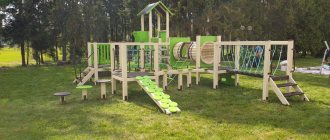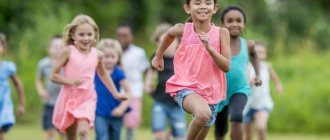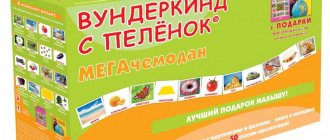While playing, a child gets to know the world, learns its laws and principles. You can compete by running and jumping and acquire various skills according to a certain algorithm - rules. Outdoor games for children will help you prepare for life and learn dexterity and ingenuity. The knowledge and skills that a child acquires during play activities help to develop correctly.
Classification of outdoor games
There are different types of outdoor games. Their classification was introduced for ease of use in practice.
Classification table:
| On what basis are they classified? | View |
| Difficulty level | sports |
| elementary mobile | |
| Activity level | low mobility |
| medium mobility | |
| great mobility | |
| Figurative content | plotless |
| plot | |
| Nature of action | competitive |
| collective |
For the little ones
For children 1-3 years old, classes in the gym are good. Nursery groups do not use games with competitive elements. All classes in preparatory groups should be health-saving.
Children aged 1-4 years are not yet coordinated, so some fun activities can be dangerous. You need to worry about preventing injuries. The very definition of games for little ones can be briefly formulated: safe, interesting, simple tasks.
For such games, the minimum group is 2-3 children. Meanwhile, music will help you have fun indoors.
The hare treats the bear
Necessary equipment for this game: 2 chairs, a bucket of water, an empty bucket, a mini plastic cup, a bear toy.
Methodology:
- Place the buckets on different chairs at a distance of 2 m from each other. Place a toy near one of the buckets.
- A full bucket is a treat from the hare for the bear
- The bucket next to which the toy is located should be filled halfway with water using a glass in which children carry water.
- The teacher (parent) reads the poem:
The brown bear is one year old,
Let's treat you to compote,
Two cute bunnies
Together with the hippopotamus.
Burner
Required equipment: chair, bucket and spoon.
Methodology:
- Place the bucket on the chair and give the child a spoon.
- The teacher (parent) reads the poem:
We cook national soup,
Cabbage soup is boiling with cabbage,
Bright, cool, useful,
And it’s delicious too!
- The child makes rotational movements with a spoon in a bucket.
The teacher reads:
Spun, spun,
And they stopped interfering!
- The child spins around himself 2 times and gives the spoon to another.
- The game continues until all children have stirred the cabbage soup.
Automobile
Required equipment: 3 chairs.
Methodology:
- Place chairs next to each other.
- The teacher (parent) reads:
I'll go to the river alone,
I'll sit down quickly.
- One of the children sits on a chair, the rest of the children continue to walk. The teacher (parent) reads:
The two of us will go to the river,
Let's invite friends.
- The second child sits on a chair, the remaining child continues to walk. The teacher (parent) reads:
The three of us will go to the river,
It will be more fun!
- The last child sits on the remaining chair. The game is over when all three children are sitting on their chairs.
The schemes are very different, but it is important to take into account age (it may be indicated in the title of the video). The selection of music used during games should be dominated by light classics and children's songs.
Precautionary measures
When conducting outdoor games, it is worth remembering safety precautions. Failure to comply with safety precautions can lead to injuries and other unpleasant consequences, so it is important to familiarize children with the rules of the game, indicate the territory in which it will be played, tell them what to do if they fall, etc.
Basic rules for outdoor games:
- Play on a safe surface: flat, without unexpected holes or bumps, preferably not too hard. The ideal surface is grassy.
- Do not play outside during or immediately after rain as the ground becomes slippery.
- If the game is played indoors, make sure it is large enough.
- Do not play games near roads or parking lots. The best place is a specially equipped closed area.
- If you use sports equipment (ball, rope, jump rope), make sure it is in good working order and tell your children about the rules of use. Make sure the guys stick to them.
- Check your children's shoes: they should be comfortable, fit firmly on the feet, and not cause difficulties when running. Clothing must also be appropriate. Do not neglect your hat if the game is played outside on a sunny day.
- If necessary, use protection: helmet, knee pads, elbow pads.
- You can prepare water so that the guys can quench their thirst after the game.
If one of the children is injured, provide first aid and, if necessary, take him to a place where he will receive qualified assistance.
Senior preschool age (5-7 years)
The school gym or courtyard is a great place to practice. So that the child does not constantly strive to play GTA and other online games on the computer, but finds excitement in movement, it is important for him to be properly offered alternative entertainment.
A card index of outdoor games will become an assistant in education and children's physical development. For older preschoolers, you can use the same stories as for others.
Sports competitions are also fun and interesting for children. Such children's outdoor games develop the following qualities:
- desire for an active lifestyle,
- endurance,
- developed strength,
- resourcefulness,
- collective spirit,
- reaction.
Goose, wolf and boy
What is developed and used: speed, agility.
Features: 7-10 children are needed to play, crayons are needed.
- Choose “wolf” and “boy”, the rest of the children are “geese”.
- Draw a circle on the site, the “geese” will hide in it.
- At a distance of 4-6 m (four meters is a minimum) draw another circle - the “wolf’s” house.
- The “geese” are initially in the “wolf’s” house, and the “wolf” is in the “geese” house.
- The “boy” kicks the “geese” out for a walk. They scatter across the site, running towards their house. The wolf reads a poem:
Day or night doesn't matter to me
I'm good at speed
I'm in the meadow
Here I will find all the geese.
I look scary though,
But I catch geese for a reason.
- The task of the “wolf” is to touch the “geese” and catch them all. The caught "geese" stands in the circle of the "wolf". The goal of the “geese” is to get into their home.
- Once all the “geese” are caught, the children change roles.
Children's volleyball
The famous but adapted version of volleyball is suitable for both kindergarten and any other group of children. An interesting and sporty game is played using a light playing ball.
Children have the opportunity to demonstrate individual skills because everyone plays for themselves. Healthy pastime will teach every child to healthy lifestyle. And summer is the best time for volleyball.
What else to read: “Don’t stay on the floor” or “Higher your feet off the ground” - an active game familiar to millions
Basis:
- 5-9 children stand in a circle.
- The child’s task is to hit the ball towards another player, or catch it.
- One game is given 6-8 minutes.
- Each participant needs to score as many points as possible:
- 1 point – for a caught ball,
- 2 points – for a hit ball,
- 5 points – if the ball was hit towards another participant at chest level.
- The one who scores the most points wins.
Owl
Includes both creative focus and motor activity. This team game is unusual and multi-component.
What is developed and involved: coordination, imagination.
Features: 8-9 children are needed to play, chalk is needed.
- A girl is selected from a group of children to be an “owl”.
- Since this is a team game, the remaining children are divided into two teams of “mice”.
- A round “mousetrap” with a diameter of 1 m is drawn on the asphalt.
- "Mice" are running around the "mousetrap". "Owl" says:
I'm an owl, Valentina,
I don't like raspberries,
I love catching mice
Wow, wow, tell everyone,
The sun is shining for everyone,
I will not eat…
- “Owl” names a word - any animal that an owl cannot eat. The “mice” must stop and imitate this animal.
- Whoever completes the task slowest goes into the mousetrap.
- The last mouse remaining outside the circle wins.
Introduction
In the development of motor activity of a preschooler, outdoor play plays a leading role. E.A. Arkin defines active play as a powerful and irreplaceable means of raising a child, the main lever of preschool education. He sees the advantage of play among various physical exercises in its emotional richness, which gives it a special appeal, mobilizes the strength of children, and brings joy and satisfaction; by the nature of motor activity, which contributes to the work of a significant mass of large muscles (running, jumping, throwing); in a variety of movements, eliminating the danger of overwork; in the ability to regulate the pace and energy of movements by the children themselves; in the manifestation of personal initiative and the development of mental qualities - courage, discipline, resourcefulness, etc.
Intense muscle activity promotes the development of flexibility of the skeleton, joints, skeletal muscles, increases their muscle strength, and develops the necessary coordination. Games promote the development of a child’s motor skills, reduce inhibition and the ability to measure movements in accordance with a task. The use of various actions and movements in the game activates the activity of the entire motor area of the cerebral cortex. Consequently, the game has a holistic effect on the child’s body, activates the interconnected functions of organs and systems, including the nervous system, which, in turn, increases the functional level of the child’s entire mental activity.
The healing effect achieved during outdoor games is closely related to the positive emotions of children that arise during play activities and have a beneficial effect on the child’s psyche. Emotional uplift (joy, pleasure, delight, inspiration) creates an increased tone of the whole organism in children. The desire of children to achieve a common goal for all is expressed in a clear understanding of the task at hand, in better coordination of movements, more accurate orientation in space and playing conditions, and in an accelerated pace of completing tasks. With such enthusiasm of children and joyful desire to achieve the goal they have captured, the role of will increases, helping to overcome various obstacles. Active play as a motor activity has certain specifics: it requires the child to quickly respond to signals and unexpected changes in the play environment. Various situations that arise in the game give rise to the need to change the nature of movement and actions, the degree of muscle tension and quickly change the direction of movement.
Such active motor activity trains the child’s nervous system, improving and balancing the processes of excitation and inhibition. For playing in the fresh air, it is typical, as mentioned above, that the child uses his movements independently: run, jump, pause, squat, walk with a careful step, etc. Thus, the child learns to regulate the degree of attention and muscle activity: depending on In a developing game situation, he can alternate movements with rest. All this contributes to the development of observation, the ability to navigate changing environmental conditions, find a way out of the current situation, quickly make a decision and implement it, take initiative, and independently choose the path to achieve the goal. Outdoor games serve as a method for improving motor skills already mastered by children.
Games for schoolchildren
Outdoor games are an opportunity to provide children with comprehensive development. Modern collections for teachers contain an interesting catalog of funny games in the form of exercises, sports and games that develop the imagination.
The importance of physical activity for schoolchildren is colossal.
This is an acquaintance with new concepts, acquiring the skills necessary in life. Of course, when introducing new games by teachers, approval will be required. List of the most important equipment that will come in handy:
- volleyball ball,
- soccer ball,
- plastic skittles,
- gates,
- basketball basket,
- checkbox.
A set of exercises that children perform during the game develops the vestibular apparatus, dexterity, speed and strength. The content and rules are not complicated, but they train your ingenuity.
The number of participants has practically no effect on the game process, but it is desirable that there be at least 10-11 children. Main classification of games:
- plot,
- sports,
- combined.
It is extremely important to choose a game for children that is appropriate for their age and season. After all, for an older child both the workload and tasks will be more difficult.
Didactic materials facilitate the educational process. These can be in the form of brochures, books and videos. All means that help parents and teachers interest modern children are good.
Sports games and exercises for preschoolers
In the physical education of preschoolers, sports games are very important. They strengthen large muscle groups, develop psychophysical qualities (strength, agility, endurance, intelligence), cultivate responsibility, will, determination, help relieve nervous tension, and release emotions. However, it is not recommended to introduce children to sports games without initial preparation. At first, it is best to conduct outdoor games with elements of sports games.
One suitable sport game for preschoolers is badminton. It uses a shuttlecock and a racket. The goal is to prevent the shuttlecock from hitting your court and land it on the opponent's side. In kindergartens, before introducing children to badminton, teachers carry out preparatory work. With the help of sports exercises and outdoor games with sports elements, specialists:
- develop in children the ability to play with the ball;
- develop appropriate posture in students;
- develop throwing skill;
- develop mobility of the hand;
- form the necessary physical qualities (reaction speed, impact force);
- introduce the rules;
- practice the basic techniques of playing badminton.
Basketball is another game that can be introduced to preschoolers. She is quite complex and emotional. It includes jumping, fast running, and throwing a ball. Some children cannot quickly master the techniques of the game. It is successfully mastered by those students who already have the skills of various ball manipulations. Before a basketball game, preparatory work is also carried out. With children, teachers master outdoor games before playing sports, perform exercises that help them learn the technique of moving and holding the ball, passing it, dribbling it, and throwing it into the basket.
Badminton and basketball are not the only games that can be introduced to preschoolers. It will be interesting and useful for children to learn about tennis and table hockey. Along with sports games, it is worth carrying out ordinary sports exercises - skating, skiing, swimming, etc. They are performed in the fresh air. In children, thanks to them, the body's defenses are increased and metabolic processes are accelerated. An additional benefit is that girls and boys gain knowledge about natural phenomena and acquire concepts about the properties of snow, ice, and water.
Junior schoolchildren
At 6-7 years old, children are accustomed to story-based games, but they need to start introducing sports elements.
Alphabet and dictionary
Purpose of the game: improving literacy, learning the native language.
Inventory: clothespins with letters, cards with words of equal difficulty.
- Children are divided into teams and choose captains.
- The captains randomly select task words for the opposing team.
- Find the letters that make up the words for the opposing team.
- The captains attach letters to the backs of the opposing team members.
- The teams line up.
- On the count of 1-2-3, the captains show the words that need to be collected.
- The team that completes the word faster by lining up in a row wins.
Hide and seek
Orientation: hide well, then run to the base.
Features of the location: a courtyard with enough safe places to hide.
- Children choose a courseworker who will search.
- The student, while at the base, closes his eyes and counts to 20.
- At this time, the participants in the game hide.
- If the courseworker finds a participant, he runs to the base and calls the name of the found participant.
- The goal of the participants: to reach the base and say their name before the coursework.
Other games
At the age of 7-8, children can already play mini-football and hockey (they will need ice at a skating rink), which will allow them to develop running speed and the ability to work in a team. At the age of 7-9, children begin to play classic volleyball.
Middle and high school students
Older students will be interested in different games than primary school students. From a pedagogical point of view, it is more difficult to captivate a teenager than younger children.
This task will be easier to cope with if new games are introduced that keep up with the times. Games in nature are especially useful for schoolchildren, because ordinary walks will not provide the necessary physical activity.
Lincoln's snowball blunder
High school students will also want to play an exciting game with a popular plot. Winter fun will captivate every child.
Features: carried out in winter, when there is enough fresh snow and not severe frost, there is sufficient space outside.
Details: a plastic bottle with colored rice (rice is painted with food coloring) will imitate a bottle of holy water; a picture depicting a city map, red and blue ribbons for each participant.
What else to read: Active child development: outdoor games at home
Story for the plot: President Lincoln fights werewolves. The werewolves are sitting in the fortress, the president and his assistants are in the apartment. They decide to go fight evil. The object of the struggle is a map of the city, which the werewolves keep in their fortress.
Organization of the game:
- The day before you need to make 2 fortresses at a distance of 9-10 m from each other, the height of a child.
- Teams of werewolves, Lincoln and his assistants are selected.
- Each participant marks himself with a ribbon: the werewolves are red, the wrestling team is blue.
- The werewolves take a position in their fortress, and the map is located in this fortress. Werewolf weapons: snowballs.
- The President and his team occupy the second fortress-apartment. Their weapons: a bottle of holy water (dyed rice) and snowballs.
- Lincoln jumps up so that the werewolves can see it and waves his hand, saying: “I won’t give you an easy life, but I’ll show you an example. The only way for you to save yourself is to give the card to us!”
- After this, the werewolf hunters try to run to their opponents' fortress and take the map. Werewolves are trying to break into the president's apartment.
- If a snowball hits a member of one of the teams, he is eliminated from the game for three minutes. When holy water hits a werewolf, he is knocked out for 10 minutes.
- The game ends when the president's team has captured the map, or if a third of the werewolves have entered the apartment.
Relay race
Relay races are known in every school; they are held in physical education classes. Conducting relay races improves physical fitness and strengthens the competitive spirit. General principle:
- Invite children to divide into teams.
- Form teams into columns at the starting line.
- On the command “March!” the captain runs (jumps) to the flag, touches it with his hand and returns to the team.
- Pats the next person in the column on the shoulder, who performs the same actions as the captain, and so on.
- The winner is the team whose last link returns to the starting line first.
Other games
High school students do athletics and run short distances. But still, they will play football with great pleasure. The purpose of outdoor play is not only to improve physical characteristics, but also to instill a lifelong love of sports.
General rules for selecting and organizing games
The correct choice of game is of great importance. It depends on the age of the children, their development, preparedness, and the number of students involved. The form of classes must be taken into account (for example, recess, lesson or holiday). During recess, short games are played to take a break from mental activity. In physical education lessons, they are already offered for longer periods, promoting the development of strength, agility, speed and other qualities. Mass games are in demand at festive events.
Participation in various types of sports and outdoor games causes slight fatigue. This feeling is useful. It, occurring systematically, helps the body adapt to increased physical activity and increase performance. But sometimes children still become overtired due to individual characteristics or because they are very interested in games and react too emotionally to everything that happens. It is very important to dose physical activity so that it does not cause overwork, because it causes lethargy, decreased appetite, and disturbed sleep.
External signs of fatigue include excessive shortness of breath, sudden redness of the face, increased sweating, and deterioration in coordination of movements. Children's interest in playing decreases. They sometimes begin to complain of fatigue and slight dizziness. If these signs occur, you should stop playing. It is worth noting that there are cases when signs of overwork are not observed. Children who are very interested and carried away by the game begin to ask the teacher, teacher or parents to continue. However, in such cases, you should not follow the children’s lead. It is important to complete the game on time.
Of course, many children participate in outdoor and sports games. In a large group, it is difficult to take into account the level of preparedness and individual capabilities of each child, so optimal loads should be planned. At the very beginning of the lesson, games that require the manifestation of significant strength, speed, and dexterity are never offered, because a warm-up is required first. If the children had a rather busy day (with a lot of mental and physical stress), then it is worth offering sedentary play. If the day was not stressful, then it is recommended to alternate intense games with low-intensity ones.





